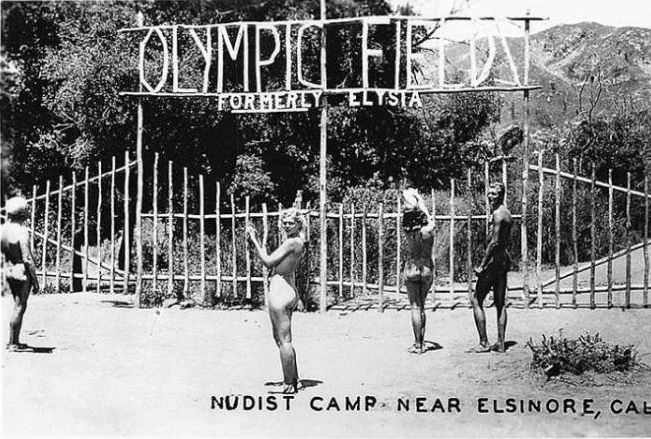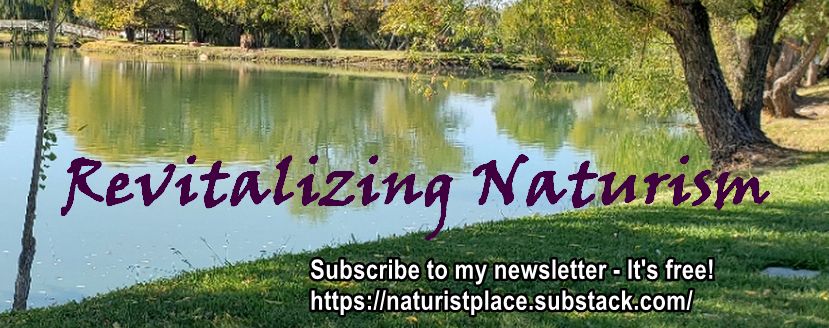
The book’s author, Sarah Schrank, is a professor of history at California State University Long Beach, so her academic credentials are good. Likewise, it’s not surprising that the book is a carefully researched, scholarly work that respects academic norms of objectivity towards the subject matter. The 35 pages of footnotes testify to the diligence of Schrank’s research. Her sources go back at least as far as 1889, although many of the references are to contemporary newspapers and similar records that would be difficult, at best, for most readers to examine.
Shrank’s purpose extends beyond simply summarizing some of the history of nudism in the U. S. (let alone anywhere else). The book’s subtitle, “Nudity and the American Cult of the Body” is somewhat unfortunate, as it suggests that nudism itself could be considered a “cult” akin, for example, to Scientology. The author, however, dispels that notion in her introduction, where she writes that the book “explores the origins, evolution, and cultural practice of a modern lifestyle that privileged nature, nakedness, and a quest for authenticity.” She states, further, that nudism’s “practitioners have consistently invested the body, nudity, nature, sex, and their concomitant spatial contexts, with heightened social and cultural significance.”
Despite the somewhat academic language, it doesn’t seem that the author’s attitude towards nudism is disapproving. Instead, she focuses on the broader issue of how in the U. S. the naked human body is understood (or much more often misunderstood) to be inextricably bound up with attitudes towards sexuality. (Of course, the same problem occurs in most other societies also.) Considered objectively, most humans tend to have a complex and unhealthy attitude towards their bodies, especially their naked bodies. Nudity per se isn’t the main issue. There are various other issues instead – sexuality, physical fitness, body acceptance, to name just a few. All these issues are reflected in the history of nudism in the U. S.
If an extraterrestrial were ever actually to visit Earth, the aversion of most humans to being seen naked would likely be perplexing, at least. The history of U. S. nudism, if nothing else, would be an excellent case study of this human peculiarity. What ET would find is that few humans are comfortable – or actually enjoy – being naked. Yet nudists have adapted in various ways to the prevailing hostility of most others toward public or private nudity. Some choose to socialize with other nudists in places where nudity is welcome or even required. (Such places are disparagingly termed “colonies” by non-nudists.) Others, who are somewhat braver, have managed to find a few beaches or other outdoor places where they can be naked (mostly) without harassment. And others are comfortable being naked, alone or with friends, only in private homes. The book discusses all these nudist contexts.
Since Schrank is based in Southern California, it’s not surprising that most of her history draws examples from that region. The first chapter deals with nudist “colonies”, and the first nudist camp in the area, named Elysian Fields by its owner, opened in 1933. (Just two years later the camp named Lupin opened in Northern California, but it’s not mentioned in the book.) Several other nudist places near Elysian Fields also started about the same time. But all of them in that area struggled with persistent legal harassment. It wasn’t until 1967 that another nudist park, Elysium, opened in the area, a little northwest of Los Angeles. (Lupin had few if any legal problems, and is still going strong.)
Southern California has an excellent climate for nudism. But most of the region was also a roaring hotbed of social and political conservatism until long after Elysian Fields opened. Elsewhere in the country, since 1931, a number of nudist places had already opened. According to one reference cited, there were already 44 by 1933. Many of those, however, also experienced legal harassment. (Nudism in Europe was more prevalent, especially in Germany, since the beginning of the century.)
The book’s second chapter deals with home nudism, much of which was also centered in the mild climate of Southern California. But it really took off only in the 1960s. As Schrank writes, “American suburbia, especially when it grew exponentially after the Second World War, proved fertile ground in which new ideas about health, fitness, sexuality, and the body could be played out in a built environment shaped by commodities, leisure culture, and single-family housing.” Given the legal climate at that time, it’s hardly surprising that people who were open-minded about nudity would choose their own homes as the best place to enjoy living without clothes. The homes they chose were designed to admit lots of sunlight and had private back yards.
Some idea of other topics in the history of U. S. nudism covered in the book can be gleaned from the titles of subsequent chapters. These include “Therapeutic Nudist Retreats”, “Swinging Suburbs”, and “How to Free a Beach”. The book can be heartily recommended for anyone interested in an objective account of this history. Unfortunately, however, there’s very little detail about anything after 1980. Ironically, that’s the year that The Naturist Society (TNS) was founded by Lee Baxandall, a midwesterner from Wisconsin, where the TNS headquarters still exists. Sadly, Baxandall later developed Parkinson’s disease. So he was unable to continue promoting naturism a few years before his death in 2008. (I was fortunate to have met him at Lupin a few years earlier.)
It’s too bad that the book’s history mostly ends where it does. But perhaps that’s not so surprising, since U. S. naturism actually began a slow decline around 1980. What happened in that particular year? Probably it’s not a coincidence 1980 was the year that an ultraconservative celebrity politician named Ronald Reagan – from Southern California, which at the time was still mostly very conservative – was elected president of the U. S. How could that have had an effect on nudism? It might well be related to the fact that people born not long after World War Two had begun entering their third decade of life, with new concerns like children, mortgages, job responsibilities, and worries about their aging parents. Consequently, there was probably less interest in raising children who could enjoy nudism as much as their parents had.
Since, however, the book has so little to say about nudism after 1980, we can only speculate. One factor, of course, was that by 1980 most of the young men and women who initiated U. S. nudism 50 years earlier were already elderly or dead. Still, evidence of declining interest in nudism was not very obvious in the 1990s. Active online discussions of nudism/naturism occurred then on the Internet and online services like CompuServe. That increased, for a while, when the Web began to take off in the later 90s. But at the same time, attendance at clothing-optional beaches was declining, as was membership in the nudist/naturist organizations TNS and AANR not long after 2000. Once-thriving nudist clubs and resorts began closing – even in Southern California. Unfortunately, good historical studies of nudism since 1980 have yet to be written, quite possibly because of flagging interest.
Nevertheless, the very last paragraph of Schrank’s book concludes on a hopeful note:
The very fact that the natural body remains an unresolved site upon which contemporary sexual politics, medical policy, and civil rights are debated makes clear that any empowerment derived from it must move beyond individual desires for expressive freedom to collective efforts for social equality. Perhaps neither nudism nor naked protest movements have managed to pull it off, so to speak, but they have forced a sustained, tenacious, and fearless rethinking of the naturalness of the human body that might ultimately free us to live more equitable, gentle, and less anxious lives.
Over 90 years have passed since nudism arrived in the U. S. And modern nudism appeared in Germany 30 years before that. Nudism is just one of many social movements that have appeared – and disappeared – over the years. Social movements, just like animal species, need to evolve or else risk extinction. But the evolution of social movements is measured in years, while the evolution of species is measured in millennia – 1000 times slower. It will be interesting to see how nudism evolves – if it is able to.

One thought on “Book review: Free and Natural”